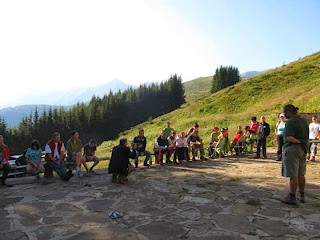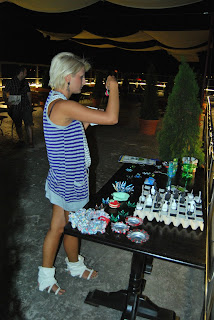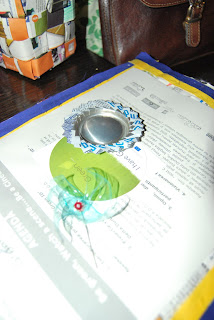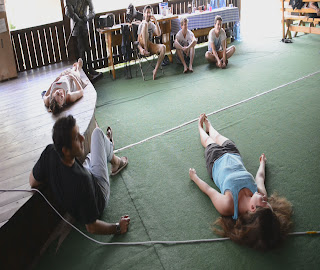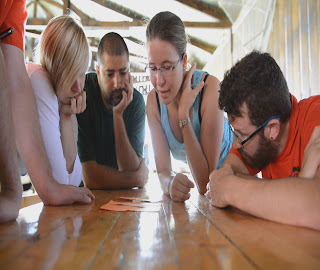Green in Spain
It was a great experience to live those days in Danube Delta with very interesting people from another countries, all the people were very interested in ecology and environmental issues and we were able to interchange knowledge on how to work this subjects with youngsters. In order to prevent environmental disasters and to promote a more eco-friendly lifestyle we must start by educating the following generations.
For that reason the dissemination activities by our association, ASOCIACIÓN BARRIOS DE LUNA, for this project were held during the previous days of cañon on festival in Tarancón (Cuenca), three days of outdoor activities on different parks of our town. The target age for this activities were children from 6-12 years old and our staff did different ways of approaching the eco-friendly lifestyle to youngsters. Storytelling, painting, and how to use different elements of the nature and recycled materials in order to decorate the spaces of the festival.
It was a really good experience for us and we have received a very positive feedback from their parents encouraging us to continue with this kind of activities all year round.
For that reason the dissemination activities by our association, ASOCIACIÓN BARRIOS DE LUNA, for this project were held during the previous days of cañon on festival in Tarancón (Cuenca), three days of outdoor activities on different parks of our town. The target age for this activities were children from 6-12 years old and our staff did different ways of approaching the eco-friendly lifestyle to youngsters. Storytelling, painting, and how to use different elements of the nature and recycled materials in order to decorate the spaces of the festival.
It was a really good experience for us and we have received a very positive feedback from their parents encouraging us to continue with this kind of activities all year round.
Mahura (Spain)
FROM THE DANUBE DELTA TO THE BULGARIAN MOUNTAINS AND SEASIDE
About a month and a half after the Green ID training course held in the village of Partizani, in the Danube Delta, Romania, one of the Bulgarian participants realized an activity from Green ID again during the For the Balkan Student Camp. The camp was organized by the Bulgarian Biodiversity Foundation and took place in the Centralen Balkan National Park, Bulgaria. It was aimed at the nature and ecological education of students and young people. Some twenty students took part in the activity My Ecological Footprint. The participants were excited to learn about the concept of the ecological footprint; they enjoyed the game and the discussion that followed proved that it has triggered their imagination and evoked a reaction.
www.bbf.biodiversity.bg/indexdetail_art.php?id=810
In the end of August My Ecological Footprint was realized again, this time on the Bulgarian seaside, during the nature conservation brigade “Atanassovsko Ezero 2013” organized by the Bulgarian Society for the Protection of Birds. Thirty of its participants took the challenge and found out where they stand in terms of sustainability. The format of the activity was well accepted though the following discussion revealed some adjustments are to be made if it is to be realistic for the Bulgarian conditions.
http://bspb.org/show2.php?id=2753&menu_id=33 (in Bulgarian)
Alexander Marinov, or Sancho, as his friends call him, says he enjoyed doing the activity in Romania and therefore decided to bring it back to Bulgaria. According to him it is a good tool to stimulate young people to think more about sustainability. He is determined to realize the activity again in upcoming nature conservation events in Bulgaria.
www.bbf.biodiversity.bg/indexdetail_art.php?id=810
In the end of August My Ecological Footprint was realized again, this time on the Bulgarian seaside, during the nature conservation brigade “Atanassovsko Ezero 2013” organized by the Bulgarian Society for the Protection of Birds. Thirty of its participants took the challenge and found out where they stand in terms of sustainability. The format of the activity was well accepted though the following discussion revealed some adjustments are to be made if it is to be realistic for the Bulgarian conditions.
http://bspb.org/show2.php?id=2753&menu_id=33 (in Bulgarian)
Alexander Marinov, or Sancho, as his friends call him, says he enjoyed doing the activity in Romania and therefore decided to bring it back to Bulgaria. According to him it is a good tool to stimulate young people to think more about sustainability. He is determined to realize the activity again in upcoming nature conservation events in Bulgaria.
After Green ID
After Green ID
2th September 2013, Šumperk - Czech republic
13:00 Welcome, introduction to the Youth in Action Programme, getting to know each other
14:30 What we TAKE from the nature and what we GIVE it - brainstorming
15:00 Presentation of Green ID project, screening documentary films Green ID
16:00 Methods of non formal learning used at the training
- Workshop 1 Air Quality Assessment
- Workshop 2 Water Quality Testing
17:00 Discussion – follow up activites
Websites: www.pointos.eu
Facebook: https://www.facebook.com/ObcanskeSdruzeniPointPodporaASocialniIntegrace
Green ID in Portugal
The Portuguese partner of Green ID - Agrupamento de Escuteiros 516 do Bombarral, made the experience in Romania famous in the regional newspaper – “Notícias do Bombarral”
How it was at Be Green, Watch a Scene…. Be a CineGreen !
In a friendly setting and with
people who look to the future and do not forget the nature, we gathered on
Wednesday, August 21, 2013 at 21:30 for the Green ID event announcing the end
of the project.
The topic of the night was raising
public awareness and discussions about environmental issues, all this contributing
to raising awareness of the effects that pollutions has on nature. Green ID encourages population,
adopting a responsible behavior towards nature.
At this event attended representatives
of specialized NGOs, young students, and people in solidarity with nature.
In the first part of the Event we
have projected suggestive images and videos from the activities at the training
course from Danube Delta, including: activities in nature, visits to local communities,
understanding cross-supply facilities, sharing of best practices in eco, workshops
for relaxation, learning to learn, knowing each other, discovering local
culture, intercultural evenings, theme parties.
We discussed about the importance
of the project, we shared ideas and possible solutions to reduce future
environmental problems. Beauty and richness of Romania was the subject
discussed towards the end of the evening, which culminated with the screening
of the documentary Wild Carpathia.
Green ID was a training held in
the Delta during the period 11 to 18 June 2013. Its purpose was to provide
youth workers methods and techniques in order to increase awareness of
environmental issues. The 24 youth workers from Romania, Bulgaria, Poland,
Portugal, Czech Republic, Spain and Hungary who participated in the project
were involved in organized activities design to increase the connection of the
participants with nature, to get them more motivated and open to adopt
sustainable practices and to promote it in their work.
Green ID activities from the training course
Activities
Training course "Green ID"
11
to 18 June 2013, the Danube Delta, Romania
Green
ID is a training course, where youth workers will join with the purpose of
improving the quality of their work in the field of environmental education for
youth. During the training course participants will discover new tools and
methods that they can use to raise awareness about the need to protect the
environment. Green ID TC is also design to increase the connection of the
participants with nature, to get them more motivated and open to adopt
sustainable practices and to promote it in their work.
1.
Greenhouse Theater
The
purpose of the activity was focus on the understanding of phenomena and the
mechanism of the greenhouse effect, global warming and climate change. The participants
were divided into 4 groups and then were asked to explain the cause of climate
change. The trainer provided a definition of the greenhouse effect, after which
the participants had to put on stage a small demonstration of how the
greenhouse effect works.
This
activity can be considered a method where young people can understand the
greenhouse effect and its consequences on human life. There were also debated terms
like "climate change" global warming "and" greenhouse gases
".
At
the end of the activity, the following questions were used for feedback: Do you
think young people can use this method? Did you find it self-explanatory and
easy to understand and apply?
For
this activity participants were divided into 4 groups and each of the group received
an object – a notebook, a can, a plastic bottle. They had 10 minutes to think
of a story in which the object is the main character and also to imagine the
object history: past, present and future.
This
method involved techniques such as story telling and presentation. Both of the
methods aimed to raise the participants awareness of the impact that man has on
nature through the things that he uses in his entire existence.
To
conclude, the questions used at the end of the activity were: Have you ever
thought about the manufacturing process of the objects you used daily? Certain
stages of this process have an impact on climate change? How? Do you think they
can be replaced? Why doesn't everybody adopt such methods if they can? Did you
learn something that you want to share with the others?
3.
The story-nature and I
The
purpose of this activity was to raise awareness presence of nature in the human
life. Using the story telling technique and Playback Theater, each participant
received an object and was asked to relate a positive or negative experience
that has influenced him and the objects supposed to be in the center of the
story. Then, the story had to be put on stage by the other participants.
The participants
were asked: If it was hard to find a relevant moment to be shared? If they
believe that nature plays an important role in their lives? What about in the
life of the others? Has nature changed in the past years? In what way?
4.
The system game
The purpose of this activity which
involves teamwork, was to raise awareness about the balance of nature and the
fact that everything humans do affects this balance. For this activity
participants were asked to choose two persons from the group (preferably not
the same persons they usually choose), but without telling them they are chosen.
Each of the participants had to be placed at an equal distance between the
people they chose. He has to keep the distance without telling the other
persons that he is the reference point. At the end of the activity,
participants were asked: how did they feel during this activity? It was hard to
follow the rules of the activity? Did they realize that they were the reference
point of other participants? Have they tried to help the others once they realized?
If yes, why? If not, why? Talk about individualism and how it affects the
environment.
5.
My ecological
footprint
The purpose of the actives was to
introduce to the participants the concept of "ecological footprint"
and making them understand the impact of personal behavior on nature.
Each participant received a
questionnaire, a pen and sat down in a straight line. Through this activity
participants will learn how their lifestyle affects the ecosystem. For each
question participants must analyze and respond to it. It has to be reminded
that the purpose of this activity is not to make them feel guilty but to but to
show the areas where improvements can be made or not. For the questions where
they are not sure, they can approximate or they can make an average. All
participants stand in a line. Each question is read, and participants have to
move forward, accordingly to the answer they give and with the rules from the questionnaire-
each answer has a certain number of steps. Also, they should also write down
the answer in the questionnaire. After reading all the questions, the group
meets. Participants will be given time to gather their score. They were
informed about “ecological footprint” concept and how they can interpret the
score:
·
- less
than 150 the Ecological Footprint was smaller than 4.0 hectares
·
- 150-350
points, the Ecological Footprint was between 4.0 hectares and 6.0 hectares.
·
- 350-550
the Ecological Footprint was between 6.0 hectares and 7.8 hectares
·
- 550-750
the Ecological Footprint was between 7.8 hectares and 10.0 hectares
·
- more
than 750 points, the Ecological Footprint was greater than 10.0 hectares.
Once
individual scores calculated we are conclude, that there are only 2.1 global
hectares (5.3 acres) of bioproductive land available per person on the Earth. And
if all people would use more then we need more land to sustain all of us.
This
work was completed with the discussion on the following questions: How did you
feel morning forward or staying behind? What behavior would you change and what
did you want to keep? Why is it possible to change some behaviors and some not?
It is a choice or a necessity to reduce your ecological footprint? What are you
willing to give up? Or what can you change? Where should we stand in the end?
Do you believe that it would be useful to do this activity with the youngsters
you work with? When? Should be adapted? If yes, how?
6.
An
imaginary day, Eco-Meeting - Eco practices in the office
The
purpose of this activity is to increase environmental responsibility in our
organizational partners. The trainer will guide the participants to imagine a
day at the office and to make a list of the objects they use, throw or recycle.
In groups of 3 participants they will have to make a collection of objects /
materials that they usually use at meetings. Starting from this they will have
to find some environmental friendly rules that can be easily used in
organizations where they are coming from. The results from the discussion will
be presented to the whole group.
The
questions at the end of the activity: Why are not adopted these rules in all
offices? Do you think these rules are hard to adopt? Once you arrived home do
you think your colleagues will adopt these rules?
7.
Letters
from the Past, How do you inspire the next generation?
The
purpose of this activity was to increase awareness among young people about the
fact that there are people and animals suffering from climate change. Through
techniques, such as story and presentation, participants were divided into 4
groups and for each group were assigned a color. Participants were told that
they living in European countries sometime in 2050. In their home suddenly
found a piece of a letter that looks very old. Each group received a piece of a
letter. It is a letter from the past! They now have to find the rest of the
letter which is hidden somewhere in the space that surrounds them. When they
have found the entire letter with the designated color they will return to the
large group. All letters will be read.
They
are lucky because 2050 was invented a machine that can lead them back to 2012,
but not earlier. Thus, they can come back in 2012 and may have the opportunity
to help the characters in the story. Reducing carbon emissions will not help
them at this stage. The stories will find many indications of how they can
help. Groups now have to think about measures that can help the people in their
stories and what they can do to ensure that that will be done. They need to do
a visual representation using the materials around them or collage using
newspapers and magazines representing a response to a letter that tells them
the plans.
Also,
this activity has released a number of questions which have been under
discussion: What do they think about writing? How did they feel? What were the
ideas to help the characters in the letters? Do they think that is realistic?
What are the obstacles in putting them into practice?
Abonați-vă la:
Comentarii (Atom)








